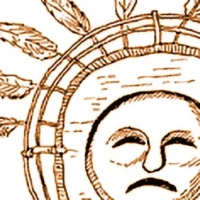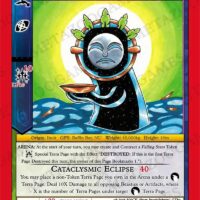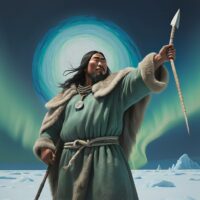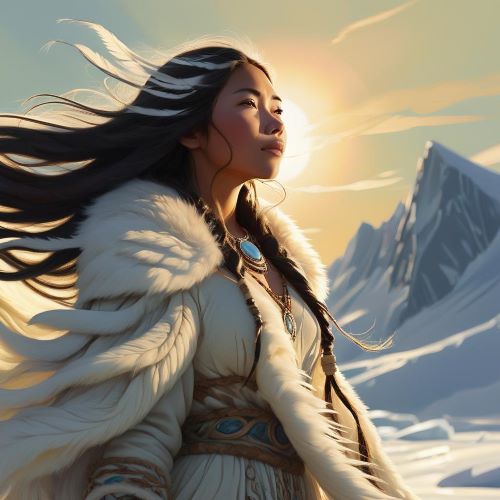Alignak : The Lunar Deity
Listen
At a glance
| Description | |
|---|---|
| Origin | Inuit Mythology |
| Classification | Gods |
| Family Members | N/A |
| Region | Greenland |
| Associated With | Moon, Tides, Weather |
Alignak
Introduction
Alginak, also referred to as Alignak, holds a prominent role in Inuit mythology as a lunar deity associated with various natural phenomena. Within the rich tapestry of Arctic mythology, Alginak is revered as a powerful and capricious figure, influencing human survival in the harsh Arctic environment. Depicted as a celestial spirit or deity, Alginak occupies a significant place in the lore and worldview of the Inuit people.
Physical Traits
Alignak’s physical appearance is subject to diverse interpretations across different Inuit communities. Some portray him as a radiant, luminous figure, glowing with the brilliance of the northern lights—a celestial spectacle revered by Arctic cultures. Others depict Alignak as a shapeshifter, able to assume various forms to traverse the realms of sky and sea. This adaptability underscores Alignak’s fluid nature within the mythological landscape, reflecting the ever-changing essence of the Arctic environment.
Unlike deities in some other cultures depicted in human form, Alginak’s physical form remains shrouded in mystery within Inuit myths. Instead of offering a concrete image, Inuit lore draws parallels between Alignak and the moon itself. The waxing and waning crescents of the moon could be interpreted as representations of Alignak’s ever-shifting moods. Lunar eclipses, where the moon appears to disappear, might symbolize moments of Alignak’s anger, while the full moon could represent his benevolence. Alignak, as a god, lacks a physical human form but is often symbolized through the moon and various weather phenomena he governs.
Family
In Inuit mythology, Alginak’s presence within intricate familial relationships reflects the interconnectedness of spiritual beings in indigenous cosmology. Some narratives depict Alginak as a celestial sibling or offspring of prominent figures like the Moon or the Sun. These familial ties deepen Alginak’s significance, illustrating the mythological kinship that binds the natural and supernatural realms in Inuit belief systems.
Alginak’s family lineage remains uncertain, though some sources suggest he is the son of Sila, the powerful air goddess, and his sister is Qailertetang, the goddess of the sea and protector of hunters. This connection underscores the interconnectedness of the natural world in Inuit mythology, where the moon, wind, and sea are governed by powerful deities. While the Inuit pantheon comprises numerous gods and goddesses, specific details about Alginak’s familial relations are not readily available.
Other names
Alginak, also recognized as Alignak, exhibits a range of names across various regional dialects and interpretations within Inuit mythology. This lunar deity’s appellations may differ based on cultural nuances and localized perspectives. For instance, Alginak might be known as Igaluk in specific contexts, emphasizing connections with the Moon or lunar phenomena. These alternate names enrich the mythological tapestry, highlighting nuanced interpretations of Alginak’s significance within Inuit storytelling traditions.
However, Alignak is not the sole name associated with this lunar deity across different Inuit communities. He is also recognized as Anuirqalik (meaning “one who regulates the tides”), Iglullik (meaning “the man in the moon”), and Ningautuk (meaning “the one who controls the weather”). These diverse names reflect varied conceptualizations of the moon god and his influence on the lives of different Inuit groups, underscoring the multiplicity of perspectives within Inuit mythology.
Powers and Abilities
Alginak wields formidable power over the natural realm, governing weather, water, tides, eclipses, and earthquakes. His influence shapes the daily manifestations of these phenomena, setting waves in motion and orchestrating the intricacies of gravitational forces. Alginak’s domain also encompasses celestial events like comets and eclipses, showcasing the fusion of natural phenomena with supernatural attributes in Inuit mythology.
Regarded as a celestial guardian or spirit of the aurora borealis, Alginak navigates the vast Arctic sky, influencing celestial rhythms. Stories attribute weather-controlling abilities to Alginak, underscoring the mythological link between natural forces and spiritual entities within indigenous belief systems. Alginak’s prowess reflects profound reverence for the Arctic landscape and the cosmic forces shaping it.
Aligned with the moon’s influence on tides, Alginak’s powers resonate deeply with Inuit livelihoods. The predictability of tides for hunting and travel underscores Alginak’s pivotal role. He commands Arctic winds, blizzards, and calm periods, crucial for safe passage and survival. Alginak’s temperament mirrors the storms he conjures; anger manifests as earthquakes and natural upheavals, while benevolence heralds clear skies and abundant hunts.
Inuit tradition emphasizes appeasing Alginak for survival. Shamans, acting as spiritual intermediaries, conducted rituals and chants to secure the moon god’s favor. Offerings of food or tools were made to Alginak to ensure favorable weather and successful hunts, cementing his vital role in sustaining Arctic life.
Modern Day Influence
Alginak’s impact in modern times is deeply rooted in the cultural and spiritual practices of the Inuit people, highlighting their profound reverence for nature and its elemental forces. While direct worship of Alginak may have diminished, his tales and legends persist within Inuit oral tradition, imparting lessons about the mysteries and power of the natural world. Despite significant changes in traditional Inuit life, Alignak’s legacy remains embedded in modern Inuit culture, reflected in art where he often appears as a face in the moon, and in stories shared across generations, reinforcing respect for nature’s power. Alignak’s influence extends even into the realm of scientific exploration. The largest crater on Pluto, discovered in 1930, bears his name—a testament to how Inuit mythology continues to shape our understanding of the cosmos.
In conclusion, Alignak transcends being merely a moon god in Inuit mythology; he embodies a formidable and unpredictable force that governs Arctic life. His sway over weather, tides, and Inuit well-being is undeniable. While Inuit life has evolved, Alignak’s legacy fosters a profound respect for nature’s power and the interconnectedness of the natural world.
In contemporary contexts, Alginak resonates within Inuit communities, symbolizing cultural heritage and resilience. His depiction in various art forms and literature underscores efforts to preserve indigenous mythology. Moreover, Alginak’s presence in popular culture reflects a broader interest in Arctic folklore and spirituality. Through modern interpretations, Alginak connects traditional storytelling with contemporary narratives, deepening appreciation for Inuit cosmology’s enduring relevance.
Related Images
Frequently Asked Questions
What is lorem Ipsum?
I am text block. Click edit button to change this text. Lorem ipsum dolor sit amet, consectetur adipiscing elit. Ut elit tellus, luctus nec ullamcorper mattis, pulvinar dapibus leo.
What is lorem Ipsum?
I am text block. Click edit button to change this text. Lorem ipsum dolor sit amet, consectetur adipiscing elit. Ut elit tellus, luctus nec ullamcorper mattis, pulvinar dapibus leo.
What is lorem Ipsum?
I am text block. Click edit button to change this text. Lorem ipsum dolor sit amet, consectetur adipiscing elit. Ut elit tellus, luctus nec ullamcorper mattis, pulvinar dapibus leo.
What is lorem Ipsum?
I am text block. Click edit button to change this text. Lorem ipsum dolor sit amet, consectetur adipiscing elit. Ut elit tellus, luctus nec ullamcorper mattis, pulvinar dapibus leo.
What is lorem Ipsum?
I am text block. Click edit button to change this text. Lorem ipsum dolor sit amet, consectetur adipiscing elit. Ut elit tellus, luctus nec ullamcorper mattis, pulvinar dapibus leo.










